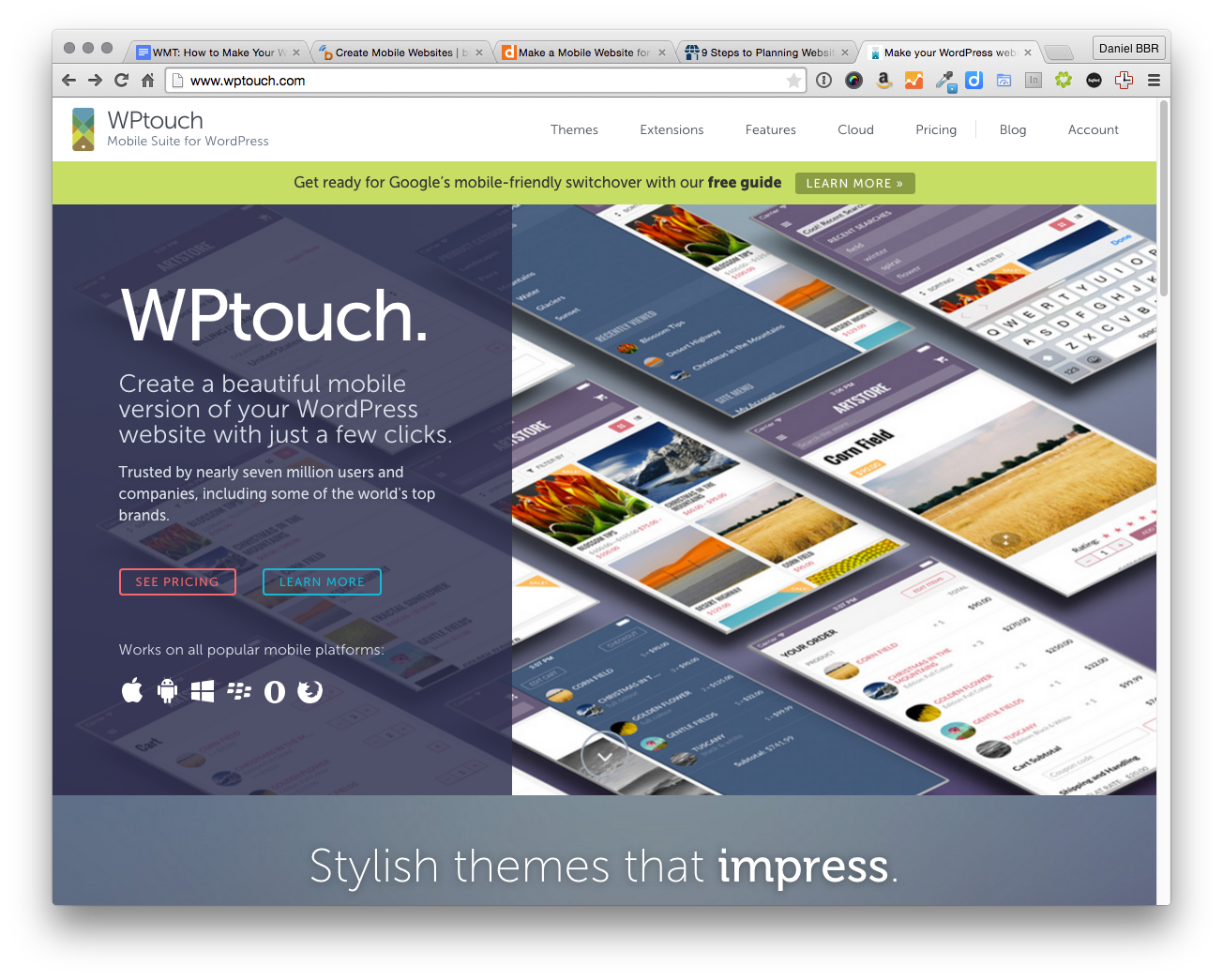In fact, 63% of all website visits in 2017 were done on mobile devices.
Having your business’ website be mobile compatible has been important since the inception of smartphone shopping.
But with mobile browsing growing in popularity, optimizing your site for the mobile experience may be the key to keeping users on your page.
Use a Mobile Website Conversion Service There are numerous companies on the web, such as Duda Mobile, bMobilized, and Mobify, who will convert your existing website for you and provide a script that will direct your mobile users to your newly created site from your main website. These services also provide you with a way to edit your content. Use YouTube or another mobile-friendly video service. They’ve already done the hard work to make your video mobile-friendly — so just upload your video, embed it, and you’re done! Check your forms. Lots of otherwise-good sites fail the mobile form test miserably. If your site has any forms, try filling them out on a smartphone.
Mobile optimization means making your website look beautiful, function properly and load quickly on mobile devices.
If your site isn’t optimized for a smooth and fast mobile experience with easy-to-read text, clear and well-formatted images, hassle-free links and prominent calls-to-action, then you’ll likely see a higher bounce rate.
In the past, mobile bounce rates were higher than desktop bounces due to mobile devices and networks being slower. And more importantly, there were less companies with sites that were optimized for mobile.
But now companies are catching up with sites that provide a great mobile experience for their customers, making the bounce rate for mobile and desktop equal. If you don’t catch up with them, your competition will leave you in the dust.
With a mobile optimized site, you can expect higher conversion rates, which can help you grow your sales and profits.
So let’s look at what you can do to make sure your website is optimized for the mobile user’s experience.
Make it Fast
When people shop on their phones, their purchases are more likely to be impulse buys.
Think about it: you’ve got 5 minutes on the train or between meetings, and you’re served up an ad for a funny t-shirt on Instagram (or an ad to win a month’s worth of free pizza, or for a pack of romance novels...whatever your vice may be).
If you can click on that ad, navigate through the t-shirt designer’s website and make a purchase in that 5 minutes, then you’ve proved the power of a mobile-optimized shopping experience.
But if any step in this process is slow to load, then you’ll bounce off the page and won’t buy the shirt. Simple as that.
How to Make Your Mobile Site Load Faster
Speed up with your site with these tips:
- Use CSS or script compression tools, like CSS minifier, CSS compressor, Gzip, or HTML compressor.
- Make your images the right size and no bigger. Bigger images will just waste load time to pull up data that isn’t going to be used. Resize your images with tinypng to tinyjpg.
- Compress your images — jpeg is the go-to format for most images on the web. Use tinyjpg.com to compress your images into jpegs.
- Use CSS effects to make those gradients, shadows, and other texturizing visuals, rather than putting that information into images.
- Rather than putting “designed” text into images that need to be loaded on your site, rely on web fonts to get the look you’re going for.
Use Fluid Layouts
A fluid layout uses automatically fits itself to the screen it’s being viewed on, so your site will always look the way it’s supposed to, no matter what device it’s on.
Web layouts used to always be sized with specification by pixel. This method is limiting when the screen size changes drastically, like from a 28” desktop monitor to a 5” phone screen.
A fluid layout can re-arrange the components of your site, which is important when adapting from the landscape-view of a desktop screen to a phone or tablet which, depending on which way it’s turned, can be viewed in portrait mode.
Design for the Fingers
On a desktop or laptop, you use a mouse or trackpad to move your tiny cursor around the screen and click on whatever you want.
But on a mobile device you use your finger, which is relatively much bigger to the screen than your cursor is to your desktop.
That means you need to make sure your site is finger-friendly.
Buttons or links, especially CTAs, should be easy to tap on without having to zoom in. And anything you want users to engage with should be designed with touch in mind.
Avoid Pop-Ups
Pop-ups are difficult to format for mobile devices. So they can be a hassle for the user to navigate or close.
The annoyance of a mobile pop-up can leave bad impression and send your user packing to go to a different site.
Don’t Rely on Flash
Some mobile devices can work with Flash. But the majority just don’t.
Neither the iPhone nor Android devices support Flash anymore, which mean if your website does, you might be creating a mobile experience that’s pretty underwhelming.
Instead, utilize HTML5 to get the effect you’re going for.
Optimizing your site for the mobile experience will make a huge difference in creating a dynamic and fluid experience for your users, leading to more conversions and sales.

But some of these steps aren’t necessarily easy to program on your own.
That’s where a professional web developer comes in.
How To Make Your Mobile Site Useful As A
Understanding customer flow and optimizing your site design to make it easy to use on any device is just part of what we do to help our clients achieve their business goals.
Our web optimization, development, and design work has increased sales for one client by 120%, upped quotes by 240% for another, and pumped up conversions by a mind-boggling 440% for yet another.
Not convinced yet? Learn more about how BKMedia can take your online business to the next level »
In fact, 63% of all website visits in 2017 were done on mobile devices.
Having your business’ website be mobile compatible has been important since the inception of smartphone shopping.
But with mobile browsing growing in popularity, optimizing your site for the mobile experience may be the key to keeping users on your page.
Mobile optimization means making your website look beautiful, function properly and load quickly on mobile devices.
If your site isn’t optimized for a smooth and fast mobile experience with easy-to-read text, clear and well-formatted images, hassle-free links and prominent calls-to-action, then you’ll likely see a higher bounce rate.

In the past, mobile bounce rates were higher than desktop bounces due to mobile devices and networks being slower. And more importantly, there were less companies with sites that were optimized for mobile.
But now companies are catching up with sites that provide a great mobile experience for their customers, making the bounce rate for mobile and desktop equal. If you don’t catch up with them, your competition will leave you in the dust.
With a mobile optimized site, you can expect higher conversion rates, which can help you grow your sales and profits.
So let’s look at what you can do to make sure your website is optimized for the mobile user’s experience.
Make it Fast
When people shop on their phones, their purchases are more likely to be impulse buys.
Think about it: you’ve got 5 minutes on the train or between meetings, and you’re served up an ad for a funny t-shirt on Instagram (or an ad to win a month’s worth of free pizza, or for a pack of romance novels...whatever your vice may be).
If you can click on that ad, navigate through the t-shirt designer’s website and make a purchase in that 5 minutes, then you’ve proved the power of a mobile-optimized shopping experience.
But if any step in this process is slow to load, then you’ll bounce off the page and won’t buy the shirt. Simple as that.
How to Make Your Mobile Site Load Faster
Speed up with your site with these tips:
- Use CSS or script compression tools, like CSS minifier, CSS compressor, Gzip, or HTML compressor.
- Make your images the right size and no bigger. Bigger images will just waste load time to pull up data that isn’t going to be used. Resize your images with tinypng to tinyjpg.
- Compress your images — jpeg is the go-to format for most images on the web. Use tinyjpg.com to compress your images into jpegs.
- Use CSS effects to make those gradients, shadows, and other texturizing visuals, rather than putting that information into images.
- Rather than putting “designed” text into images that need to be loaded on your site, rely on web fonts to get the look you’re going for.
Use Fluid Layouts
A fluid layout uses automatically fits itself to the screen it’s being viewed on, so your site will always look the way it’s supposed to, no matter what device it’s on.
Web layouts used to always be sized with specification by pixel. This method is limiting when the screen size changes drastically, like from a 28” desktop monitor to a 5” phone screen.
A fluid layout can re-arrange the components of your site, which is important when adapting from the landscape-view of a desktop screen to a phone or tablet which, depending on which way it’s turned, can be viewed in portrait mode.

Design for the Fingers
On a desktop or laptop, you use a mouse or trackpad to move your tiny cursor around the screen and click on whatever you want.
But on a mobile device you use your finger, which is relatively much bigger to the screen than your cursor is to your desktop.
That means you need to make sure your site is finger-friendly.
Buttons or links, especially CTAs, should be easy to tap on without having to zoom in. And anything you want users to engage with should be designed with touch in mind.

Avoid Pop-Ups

Pop-ups are difficult to format for mobile devices. So they can be a hassle for the user to navigate or close.
The annoyance of a mobile pop-up can leave bad impression and send your user packing to go to a different site.
Don’t Rely on Flash
Some mobile devices can work with Flash. But the majority just don’t.
Neither the iPhone nor Android devices support Flash anymore, which mean if your website does, you might be creating a mobile experience that’s pretty underwhelming.
Instead, utilize HTML5 to get the effect you’re going for.
Optimizing your site for the mobile experience will make a huge difference in creating a dynamic and fluid experience for your users, leading to more conversions and sales.
But some of these steps aren’t necessarily easy to program on your own.
That’s where a professional web developer comes in.
How To Make Your Mobile Site Useful Items
Understanding customer flow and optimizing your site design to make it easy to use on any device is just part of what we do to help our clients achieve their business goals.
Our web optimization, development, and design work has increased sales for one client by 120%, upped quotes by 240% for another, and pumped up conversions by a mind-boggling 440% for yet another.
Not convinced yet? Learn more about how BKMedia can take your online business to the next level »
